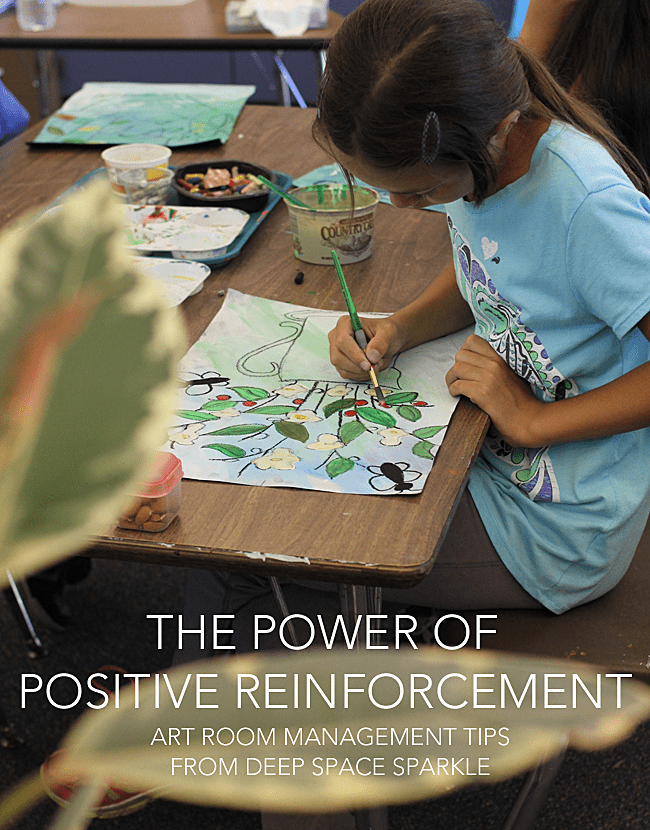
Do you ever arrive at work with a new lesson plan that you are totally excited about? Then your students arrive with less-than-stellar attention spans?
We all dream of the perfect class, filled with well-behaved, little angels but then reality hits. Slowly the excitement of unveiling a brand new lesson floats away as you try to corral the little ones back to their seats or at least get them looking in the right direction. My technique has always starts with positive reinforcement.
Classroom Management
Sometimes, it’s not about the cool project, but basic classroom management. Dealing with the late arrivals, kids who need a drink of water right in the middle of your demonstration, the girls who can’t sit with each other, the kids who insist on talking while you are talking and the list goes on. Soon you feel your earlier enthusiasm morph into a state of frustration.
The tricky thing about being a teacher, an especially an art teacher who sees many students per day, is not letting student behavior dictate the mood of your classroom. It’s really easy to slip into feelings of self-doubt or the feeling of being taken advantage of or not be appreciated, but the sooner you can let go of these emotions, the happier you will be.
I learned a lot about classroom management form Michael Linsin and his blog, Smart Classroom Management. Earlier this year, I interviewed him during which he said so many relevant things that helped me in the art room. His main point is to have a classroom management plan that works for you, that you believe in and that you can do consistently without effort. I love his common sense approach to working with kids and I know his words will resonate with you.
He recently wrote Classroom Management for Art, Music, and PE Teachers. I was given a copy this summer and read through the book in one sitting.
For me, Michael’s most striking and effective management tactic is to tell a child that he broke one of your classroom rules in the most direct, non-negotiable way possible, then, and this is what I love, the next time you see that student, don’t treat him any differently. Treat him without judgement.
I love this clean-slate approach to discipline as it’s so easy to forget that children are growing and learning. If they acted poorly but experienced the consequences, they deserves to start fresh the next time.
This general fondness for students goes a long, long way in creating a classroom where students want to come and enjoy the learning process.
A Little Positive Reinforcement Goes a Long Way
I’ve gotten better at dealing with the various personalities that walk through my art room door. A few years ago, I was eating lunch in the teacher’s lounge when a teacher asked the principal how to handle a problem. One of her students was doing something he shouldn’t. The principal responded by saying, Remember, every moment is a teaching moment. Be positive with the child. Instead of saying, ‘don’t do that’, say ‘do this’ instead.
I’ll always remember that small piece of advice.
Every moment is a teaching moment.
It’s so valuable to have a mantra that you can tell yourself when a student misbehaves. For me, this one reminds me that I’m the adult and these children are someone’s baby and that I need to do what I do best: teach.
So when my students come into art class, I choose positive words as I instruct them.
- “Sit at a spot with a blue paper,” instead of “Don’t sit there.”
- “Put your hands on your lap,” instead of “Don’t touch the supplies.”

I certainly don’t know the psychology behind it, but I do believe that teaching in a positive tone makes all the difference between an engaged class and a distracted one.
As you practice positive dialogue, you’ll catch yourself when you say something negative. Your brain will beep into action and you’ll notice it. And if you notice it, so will the kids.
Just something to think about!
Do you have a management tip that works well in your art room? Have you read Michael’s new book? Please share!
New to teaching art in the classroom? Download my free classroom art teachers toolkit by clicking the yellow box below!












Great Reminder!
Please let me know your best ideas for a 30 minute back to back elementary art schedule. Classroom management is very tricky. Please let me know your ideas on behavior management for this type of time schedule.
Thank you!
Peggy
This is a great question for our DSS Facebook Page. I’ll post there. Make sure to like the page here: https://www.facebook.com/pages/Deep-Space-Sparkle/51340204099
Amazing how those little tweaks make such a big difference. That positive spin takes some getting used to ( I have to stop and think a lot how to word my directions), but I have found the kiddos are so much more inclined to respond positively!
Thanks for this post. Had an art class yesterday and the kids were driving me crazy! As a parent volunteer, days like this make me want to throw in the towel but your post is very encouraging.
Good reminder! I don't have assigned seats in my art room, so I always tell the kids as they are coming in, "Choose a seat where you can be successful… not next to someone you'll be tempted to talk to!"
What great advice. Applies to "big kids" in your life too, I am sure. Helps with family squabbles so no one's nose gets out of joint. You're not trying to tell them what to do, you're suggesting. A very good reminder. Did your winter tree with the red cardinal and red fox the other day with my granddaughter and it's a masterpiece! Thank you always.
Great advice for teachers and parents alike! I just love your blog!
:)Erin
Great advice for teachers and parents alike! I just love your blog!
:)Erin
If you love this type of discipline you should read Teaching with Love and Logic by Jim Faye. All his books are filled with tips to use enforceable statements and how to make your life easier when dealing with your students and even your own kids.
Thanks for the book rec! I'll check it out.
Thanks! I need this today! 🙂
Great reminder, especially for this time of year. It definitely takes practice to make it an automatic response and it really does work! Thanks.
Are your art classes quiet? Do you allow your students to interact verbally with one another? I teach art elementary and was wondering what type of noise level you allow in your class. Thanks.
Good question. For most of my lessons (not all), I give a ten minute demonstration, followed by a few minutes of getting everyone engaged in the project and then I ask the children to work without talking for 10 minutes. I do this for K-6. K does it easily. 6th grade does it easily. The classes in between, sometimes harder!
I don’t project it as punishment, but more of a “me” time. A chance to work on the project without anyone commenting, judging, interfering.
It really helps focus the kids. After that, I encourage the students to work however they like. Still, having said that, each class is different and I like to adjust for certain situations.
As a new art teacher, I love the practical guide you mention about classroom management! Love your site! Thank you!
Thanks Mary!!!!
I have this book. I think the most powerful point he makes is that art teachers have an advantage over regular classroom teachers because kids love art. Art of Education offers an online class on classroom management that uses this book.
nice post
I am retired teacher form Georgia, now working as a sub in Florida. I loved being a member of DSS while I was teaching. My small county has finally added art to the curriculum and I will be able to sub. Do I still have access to the bundles I purchased?
This group has enabled so many new art teachers become successful. Thank you
Hi Katherine! Great question. If you decide to rejoin The Sparklers’ Club, you can jump back in right where you left off. We’ve saved all your unlocked bundles for you! You just have to use the same email. If you are thinking about joining The Sparklers’ Club you should get on the Sparklers’ Club waitlist click here: https://thesparklersclub.com/join/